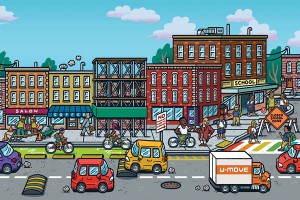“This Is the Lovely Master Bedroom, Where the Bodies Were Found…”
It’s a question that serves to divide people pretty neatly: What if you found the home of your dreams, then discovered that a horrible crime once took place there?
“I wouldn’t have a problem with that,” says my friend Annie.
“I’d never buy a place like that,” says my friend Christy.
“What difference would that make?” asks my husband.
“Would I get a break on the price?” asks my son.
This may seem like fodder for late-night, wine-fueled debates, but recently Pennsylvania’s Superior Court agreed with Annie and my son and husband, ruling that a home’s sellers have no legal duty to disclose even the goriest of crimes to have taken place under its roof. In the case, buyer Janet Milliken argued that Kathleen and Joseph Jacono, owners of a handsome Delaware County home she purchased in 2007, had a legal duty to inform her of a murder/suicide on the premises the year before. Milliken’s attorney argued that the crime amounted to a “material defect” that decreased the value of the home. (Milliken paid $610,000 for the house, which the Jaconos had bought at auction four months earlier for $450,000.)
In making its decision, the panel of Superior Court judges noted several problems that requiring such disclosures would pose:
“First, how recent must the murder be that the seller must inform the buyer?” In other words, how far back would such a requirement reach? Ten years? Fifty? The Civil War era? An Indian massacre in the backyard?
“Second, how can a monetary value possibly be assigned to the psychological damage to a house caused by a murder?” Since knowing about such a murder wouldn’t bother my husband at all but would totally give me the heebie-jeebies, who’s to decide how much the price should come down?
“Third, is this disclosure limited to murder, or must other crimes be revealed also?” What about rape? Child molestation? Beatings? Insurance fraud?
I know I’d see bloodstains everywhere I looked in a murder house. Not so for Peter Muller, owner of the Houston home in which Andrea Yates notoriously drowned her five kids in 2001. He bought the property in 2004 for $87,000 and estimates it’s now worth more than $120,000. “It’s a good location,” Muller told a Fox News reporter back in August. He also noted, “I really don’t care about the history. I don’t think about it, it doesn’t bother me.”
The same goes for Chris Butler, who purchased a lovely ranch house in Bath, Ohio, back in 2005. He got it for a steal—it was the site of Jeffrey Dahmer’s first murder, where he killed a 19-year-old hitchhiker with a barbell, cut up the body, and buried it in the scenic nearby woods. “The house didn’t kill anybody,” Butler, who put the house up for sale himself late last year, wrote in a 2009 NPR piece on the place where he lived. And hey—he saved himself $100,000.
Some people will put up with almost anything for the sake of a real estate deal. The California condo where O.J. Simpson may or may not have killed Nicole Brown, the Colorado home where JonBenét Ramsey died, the Amityville Horror house in rural New York—all eventually found new owners, though they sold for much less than comparable homes. Real estate agents call such properties “stigmatized,” the same term they use when a house has been the site of a suicide or reported paranormal activity.
Of course, if you live in an old house—ours was built in the late 19th century—chances are pretty good somebody died there sometime, especially since Americans once routinely expired at home. (It’s still where we’d prefer to die; though 70 percent of us say we want to, um, give up the ghost in our own beds, in actuality, that’s how many die in hospitals.) And that doesn’t bother me a bit; in fact, I find it sort of comforting that these sturdy brick walls have seen the whole wonderful circle of life, yada yada ya. But to bathe my babies in the bathtub where Yates murdered hers? That would creep me out.
“Ghosts aren’t real, Mom,” my smart-ass son says when I voice my objection. But it’s not ghosts I’d worry about, exactly. I don’t believe in ghosts. What I do believe—and I’m not especially happy with myself for feeling this way—is that evil can leave a sort of cosmic trace. Photographer Joel Sternfeld became known for his photographs of the sites of infamous crimes, including the leaf-strewn spot in Central Park where “Preppie Killer” Robert Chambers murdered Jennifer Levin in 1986. His works evoke the same sensation I’d have if I lived in a house where someone had been murdered: They seem always to be waiting for the killer to come walking into the picture. If I didn’t know about the crimes, of course, I wouldn’t feel that way.
Some owners make lemonade with their lemons: The homestead in Fall River, Massachusetts, where Lizzie Borden gave her mother 40 whacks is now a bed-and-breakfast and museum. And in England, where houses—and memories—go back farther, people seem more, well, sanguine about their domiciles’ sanguineousness. A Guardian article on the subject of stigmatized houses quoted a woman who encapsulated the yin/yang of such real estate: “There’s a chunk of this nation who like to sit on loos no one’s used before. Then there are others who love the feeling of an old bedroom.” Even one where wrongdoing may have been done.
But now the Superior Court has decreed that the sellers of a murder house have no duty to inform buyers of its history. And if I don’t’t know about a murder on the premises, how can it bother me? Of course, even if the sellers keep their mouths shut, well-meaning (?) neighbors have been known to spill the news after the fact. Kevin Firth bought his house in Anfield, England, unaware of a sensational murder that took place in its front parlor in 1931. A helpful cabdriver clued him in after the purchase, while driving him home. “It should have been down to me to check the history of the place,” Firth told the Guardian. “But when you buy a house, you think, is the place subsiding? Has it got damage? You don’t think, now, shall I just check and see if one of the most infamous murders ever in the world happened here?”
If you’re like me, from now on, you will.


